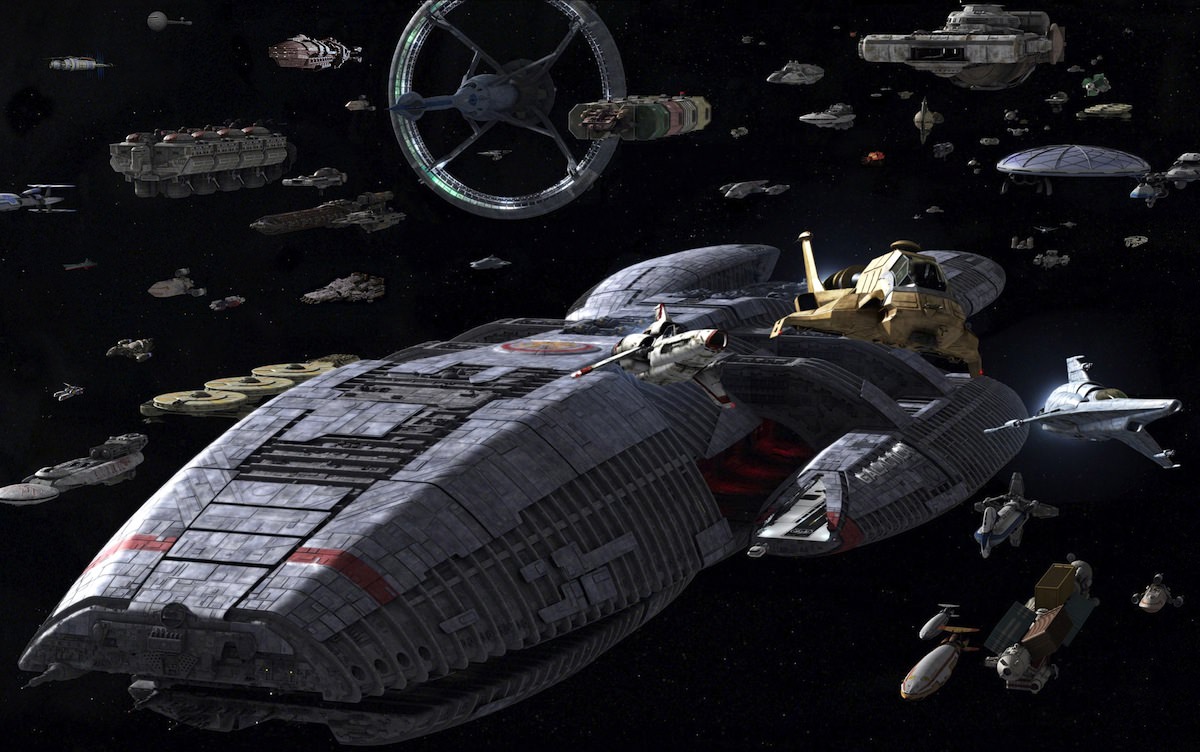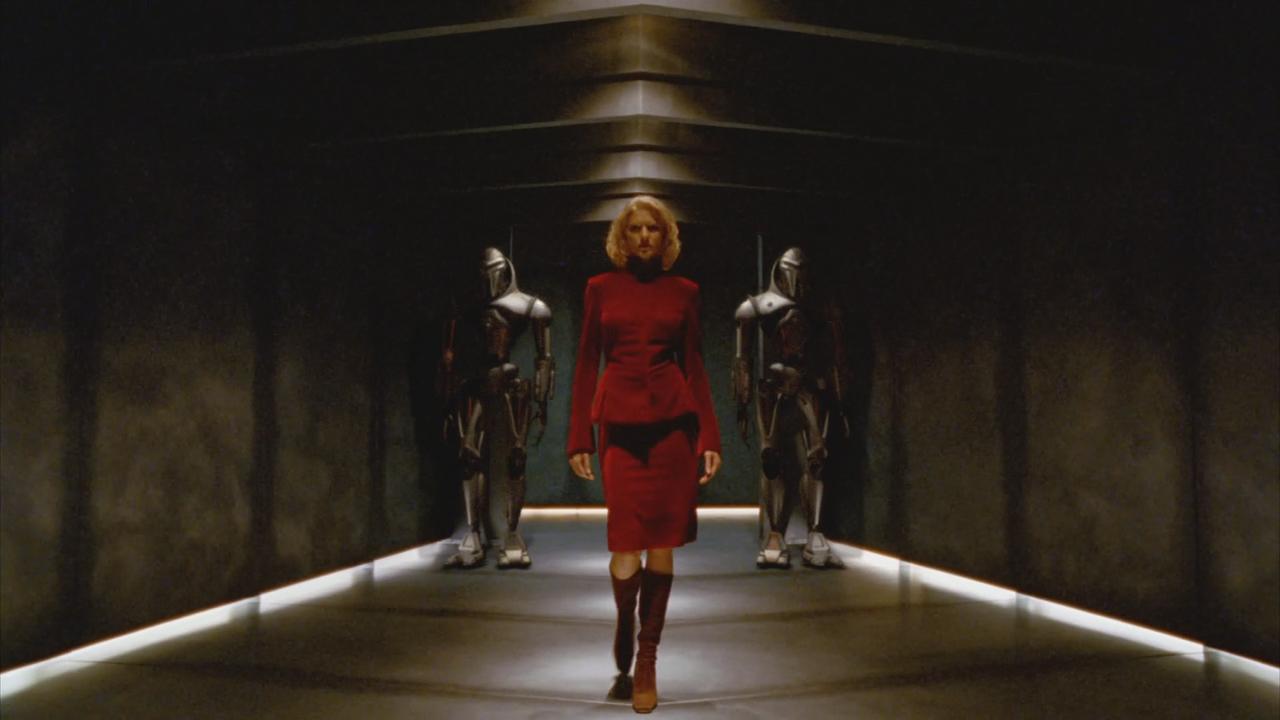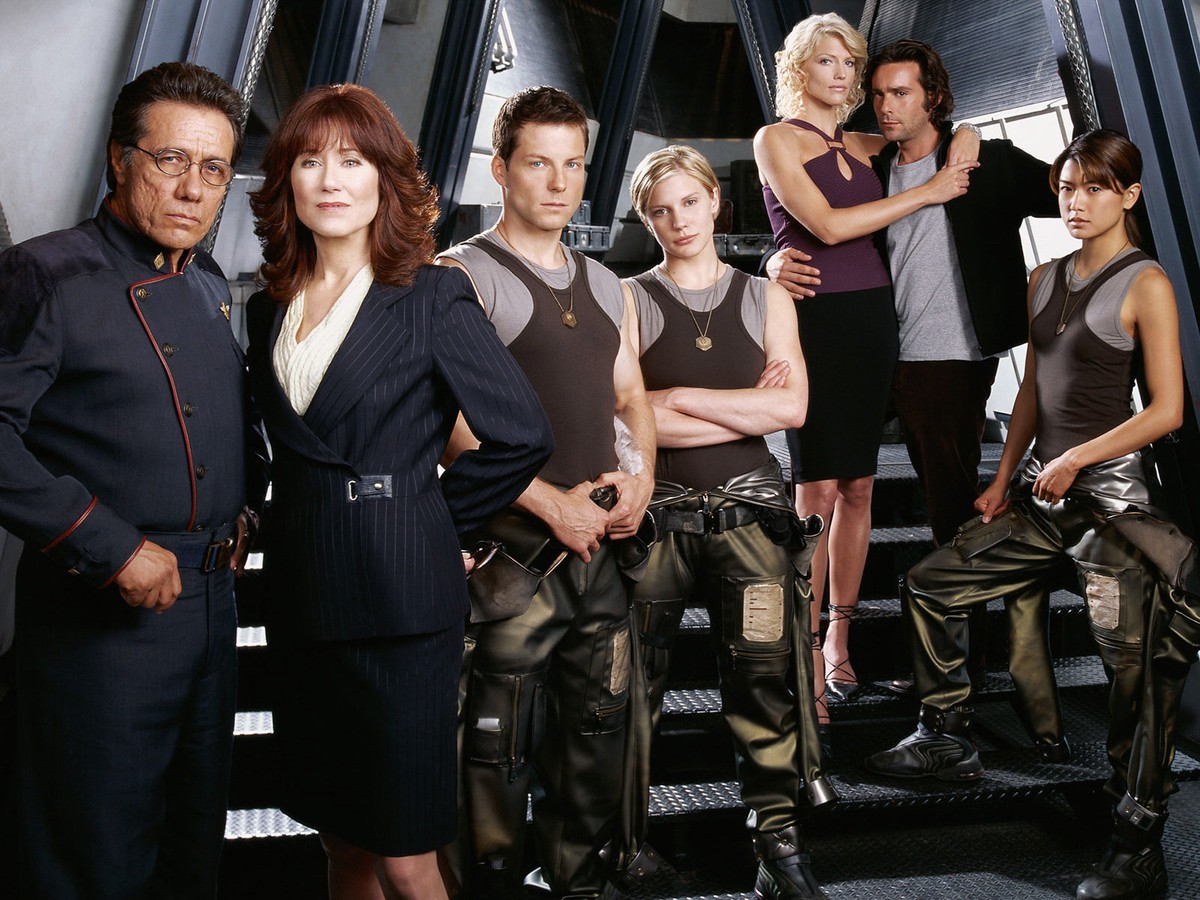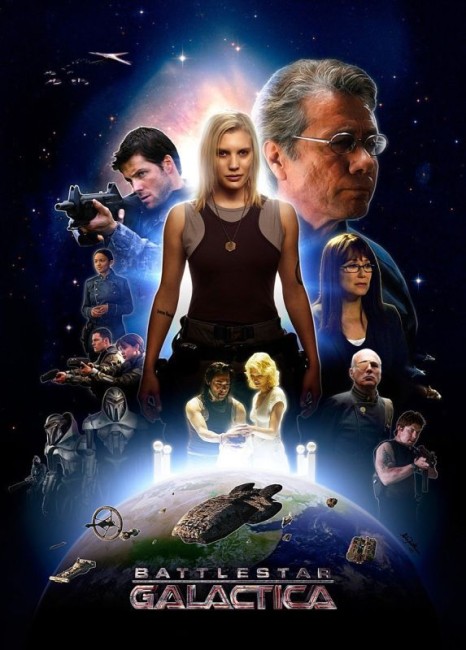Crew
Director – Michael Rymer, Teleplay – Christopher Eric James & Ronald D. Moore, Based on a Teleplay by Glen A. Larson, Producer – Harvey Frand, Photography – Joel Ransom, Music – Richard Gibbs, Visual Effects Supervisor – Gary Hutzel, Visual Effects – Zoic, Special Effects Supervisor – Stewart Bradley, Production Design – Richard Hudolin. Production Company – Universal/Cable Entertainment LLC.
Cast
Edward James Olmos (Commander William Adama), Mary McDonnell (President Laura Roslin), Jamie Bamber (Captain Lee ‘Apollo’ Adama), Katee Sackhoff (Lieutenant Kara ‘Starbuck’ Thrace), James Callis (Dr Gaius Baltar), Tricia Helfer (Number Six), Grace Park (Lieutenant Sharon ‘Boomer’ Valeri), Michael Hogan (Colonel Tigh), Aaron Douglas (Crew Chief Tyrol), Paul Campbell (Billy), Callum Keith Rennie (Leoben Conoy), Kandyse McClure (Duella), Connor Widdows (Boxey), Alessandro Juliani (Lieutenant Gaeta), Matthew Bennett (Doral)
Plot
The Twelve Colonies of humanity created the robotic race of Cylons as servants but the Cylons evolved beyond their programming and then turned on humanity. It is forty years since anyone has heard from the Cylons. On the Colonies’s capital Caprica, genius designer Dr Gaius Baltar is startled when the woman he has been sleeping with reveals that she is a Cylon that has been created indistinguishable from human. She has used her nearness to Baltar to insert a computer virus in the planetary defence grid, which now shuts down defences everywhere as the Cylons attack the Colonies en masse. It is only the Battlestar Galactica under Commander Adama, on its way to be decommissioned, that survives because its systems are not networked to the defence grid. With the colonies devastated, education secretary Laura Roslin is appointed the new President. She pushes Commander Adama not to attack back but to form a fleet of all the faster-than-light capable spaceships. Gathering some 50,000 survivors aboard ships, they head away into the unknown. Soon they come to the realisation that there are Cylon agents and even Cylon sleepers – humans that do not realise they are Cylons – aboard the fleet.
The original Battlestar Galactica (1978-9) tv series was one of the first works to come out in the science-fiction boom that greeted the success of Star Wars (1977). Battlestar Galactica was blatantly imitative of Star Wars – copying the same tiny ships having intergalactic dogfights, the same ship designs, the same cute robots, the same cocksure pilot character and so on – to the extent that George Lucas sued for copyright infringement. Battlestar Galactica only lasted on air for fifteen episodes, not because it lacked a fan following – in fact, it developed a more than reasonable audience share – but because it was the most expensive tv series ever produced at the time and Universal could not justify the continued outlay of cost. It was revived for a further ten episodes as the much hated Galactica 1980 (1980), where the costs were scaled down by relocating the series to contemporary Earth. The pilot episode Battlestar Galactica (1978) was released in a slightly edited form to theatrical audiences outside of America and then subsequently inside the US as well. International audiences also saw a further two Battlestar Galactica movies – Mission Galactica: The Cylon Attack (1979) and Conquest of the Earth (1981) – that were reedited from episodes of the two tv series.
Battlestar Galactica fandom remained enthusiastic after the demise of the series. There were a number of original novelisations and a comic book series, even a series of trading cards. In the late 1990s, around the time of Star Wars Episode I: The Phantom Menace (1999), there were persistent rumours of a Battlestar Galactica revival – both as a film or a tv series. Richard Hatch, who played Apollo in the original series and wrote four Battlestar Galactica novelisations, was one of the most passionate voices behind this, even going so far as to raise money to make a 4½-minute trailer as a demo for a new show that would follow on from the end of the first series and bring back many of the surviving original cast. About the same time, Todd Moyer, the producer of Wing Commander (1999), and Battlestar Galactica creator Glen A. Larson announced a $40 million theatrical remake, which would have starred a newer, younger cast and was even at one pointed mooted as an IMAX movie. The two Battlestar Galactica projects warred with one another and Universal over who did and did not own the rights and whether the revival would be on tv or the movie screens. Bryan Singer, the director of X-Men (2000), then entered the fray and announced that he wanted to direct a pilot for a new Battlestar Galactica series. Sets were built in Vancouver but the deal collapsed when Singer departed over scheduling to direct X2 (2003), although apparently Singer is still talking about the film for release in the 2010s.

The Battlestar Galactica revival finally came about with this tv mini-series, which screened in two-parts over four hours. This was later expanded into a tv series Battlestar Galactica (2004-9), which continued on from the plotlines in the mini-series and featured all of the cast here. The man behind Battlestar Galactica 2003 was Ronald D. Moore. Ronald D. Moore has an eminent pedigree in genre tv, having worked as a producer on and written numerous episodes of Star Trek: The Next Generation (1987-94), Star Trek: Deep Space Nine (1993-9) and Star Trek: Voyager (1995-2001). Moore also wrote the scripts for two of the Next Generation films, Star Trek: Generations (1994) and Star Trek: First Contact (1996), and wrote-produced other genre tv series such as Roswell (1999-2002) and the excellent Depression Era fantasy series Carnivale (2003-5). Subsequent to Battlestar Galactica, Moore has gone on to produce other genre shows such as Helix (2014-5), Outlander (2014– ) and Philip K. Dick’s Electric Dreams (2017-8).
For all the avid fanbase that surrounds it, the original Battlestar Galactica was a poor series. It was written by people who knew little about science-fiction. The basic conception of the series was riddled with bad science and most of the plots were merely Westerns or war movies that had been rewritten with robots for Injuns, rayguns for six-shooters and so on. On the other hand, Battlestar Galactica 2003 (and the subsequent series) is extremely good science-fiction. Indeed, when details of the new series first leaked out online, there was a backlash from fans of the original Battlestar Galactica who castigated Ronald D. Moore for not continuing on from the old series, for rewriting everything from scratch and not including any of the original cast (although Richard Hatch did turn up in a continuing role in the subsequent series). It is to Ronald D. Moore’s credit that he has stood his stead. The other versions of Battlestar Galactica that were postulated – Richard Hatch’s trailer and Glen A. Larson’s planned big screen revival – seemed to only go back and take themselves from the carelessly conceived original, whereas Ronald D. Moore has the boldness to take the basics and remake them into good science-fiction.
The reconceptualising of the original series is immediately apparent from the opening scene where a lone ambassadorial attaché sits on a space station awaiting the Cylons and the camera pointedly moves from a shot of him looking at the schematics for a Centurion from the old series to the door opening and the new Cylons appearing, a duo of lethal armoured robots but still with the recognisable single red eye scanning back and forward and the accompanying low humming sound effect, before they are joined by the breathtakingly gorgeous Tricia Helfer who proceeds to seduce the attaché and then blow the station up. Before we have had time to adjust, there are a handful of scenes that proceed to shake up familiarities with the original show. We see the Galactica, which looks the same as before but we learn is obsolete and on its way to be decommissioned (although, one must say that the old model for the Galactica had a boldness of design that the new sleekly armoured and battle-lined Galactica here does not). We meet Lieutenant Starbuck, who is still a hot-headed pilot with a love of gambling, stogies and punching out senior officers – but is now a woman (Katee Sackhoff). Count Baltar is present – in the original he was simply a traitor who in an ill-resolved plot element later inexplicably became the leader of the Cylons, but here both elements are sort-of combined and he is shown as egocentric genius who is keeping the secret that he allowed the planetary grid to fall by granting access to a Cylon agent (Tricia Helfer), who continues to turn up throughout (and in the subsequent series) in his head having conversations with him.

Many of the elements that did not work in the original or were superfluous have been eliminated – Adama’s daughter Athena has been written out; there is no equivalent of Cassiopeia the ‘socialator’; there is a Boxey, the character that was written in for cutsie kid appeal, but he is kept well to the background and there is no Muffitt II the robot dog. There is no equivalent of Jane Seymour’s Serena, the journalist who was introduced in the pilot and became Apollo’s love interest before being killed off in the second episode, although the character has a sort-of equivalent in Mary McDonnell’s President who develops a friendship with Apollo.
There are other intriguing changes – most of the characters in the original Ballestar Galactica have some counterpart here but names like Apollo, Starbuck and Boomer are now only pilots’ call names and all of the characters have English Christian and surnames, which makes for some intriguing implications about the back history to the Colonies. The mini-series even pumps up the heated sexual content (or at least as much as it can get away with on US tv) that the chaste original never ever ventured into. At the same time, the mini-series also happily acknowledges and makes in-reference to the original – a showcase in the background has models of a Cylon basestar and Centurion on display and there is reference made to the death of Adama’s other son Zac.
The show is also given a much more grittily realistic look. Emphasis is placed on the Battlestar Galactica as a military vessel – all looming bulkheads and bristling militaristic bustle. Moreover, the mini-series employs the roving camerawork patented by series like NYPD Blue (1993-2005), where the action has been shot documentary-style as though with an unsteady handheld camera. Even the scenes of aerial combat are shot with roving camerawork, which is a considerable novelty when one considers that these are model and visual effects sequences. The effects sequences themselves are stunningly good. Indeed, Battlestar Galactica is one of the first modern space operas to try and do something genuinely different with and reconceptualise the standard Star Wars dogfight sequence. We see dozens of Vipers in combat all at once, twirling and shooting up Cylons, evading missiles. There is an exhilarating dynamism to the action – the sequence where Starbuck rams Apollo’s damaged Viper to bring it into the landing bay is a genuinely hair-raising scene.
The mini-series also changes the nature of the Cylons somewhat. While the one-eyed robots are present, they are not the principal menace and instead the threat is now Cylons that have evolved to the point that they can perfectly and undetectably imitate human form. This turns Battlestar Galactica from a standard war with the evil robots story into more of a Philip K. Dickian paranoia story where we cannot be sure who aboard is a Cylon or not. In this regard, the mini-series has a beautiful double sting in the end of the tale where both the character that we gained the impression Baltar framed as a Cylon sleeper proves to be one after all, and in the chill final fadeout so too does one of the least likely characters aboard the ship.

The show is well cast and there are uniformly excellent performances throughout. The casting of Edward James Olmos as Commander Adama takes one aback and requires some getting used to. In the original series, Lorne Greene brought a commanding patriarchal authority, as well as prior association from tv’s Bonanza (1959-73). Edward James Olmos’s Adama is almost the complete antithesis of Lorne Greene’s Adama. Olmos plays with his characteristically cold tight-lippedness – his Adama seems like someone who has all his emotions tightly locked away and guards every communiqué he makes with others. Where Lorne Greene seemed to hold a wise patriarchal dignity, Olmos’s Adama seems like an intensely private person who one gets the impression would rather shun all human contact. The best character on the new series is Mary McDonnell’s President. Here Mary McDonnell gives a strong and coolly intelligent performance. The writing of the character and the choices we see her making is excellent. Indeed, throughout the mini-series we often see a fascinating conflict between the pragmatic militarism of Edward James Olmos’s Adama and Mary McDonnell’s more humanitarian President, a political division that the original series never even dreamed of.
What one also particularly liked about the new series is that it does not shy away from the brutal decisions and issues of survival that must be made. Whereas the original Battlestar Galactica told hackneyed Western plots dressed up in science-fiction guise and largely forgot about problems getting food and fuel except whenever these could be resurrected as plot points, the remake and subsequent series places the emphasis strongly on the characters and the moral survival decisions they must make and brought these to the forefront of every episode. In the mini-series here, we see the crew having to make extraordinarily brutal decisions like the choice to open the bulkheads and evacuate 100 personnel into the vacuum of space in order to prevent a fire that could destroy the ship (an echo of the Fire in Space episode of the original series), or where the decision is made that in order to save the fleet that every FTL ship must jump and some 10,000 people in non-lightspeed capable ships be left behind to be killed by the Cylons. Not even Star Trek managed to push Captains Kirk or Picard to have to make such tough choices.
The resulting series enjoyed a strong fanbase and has lasted on air far longer than the original. The level of writing was uncommonly strong and the series stands as excellent science-fiction. Battlestar Galactica: Razor (2007) was a stand alone film made as a tv special that was released to theatres in some parts of the US. This was followed by a further original film Battlestar Galactica: The Plan (2009), as well as a prequel series Caprica (2009-10), which only lasted for eighteen episodes, and a further prequel web-series Battlestar Galactica: Blood & Chrome (2012).
(Nominee for Best Adapted Screenplay, Best Actress (Mary McDonnell) and Best Special Effects at this site’s Best of 2003 Awards).
Trailer here

